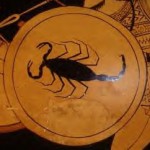By Adrienne Mayor (Wonders and Marvels contributor)
(Wonders and Marvels contributor)
“Scorpions are a horrible plague,” declared Pliny, “poisonous like vipers except that they inflict even worse torture by killing their victims with lingering, painful death that lasts three days.” “Everyone detests scorpions” chimed in Aelian, another natural historan of ancient Rome. In the desert of the Middle East the deadly creatures “lurk beneath every stone and every clod of dirt.” Scorpions posed such a menace along the caravan routes that Persian kings of antiquity routinely ordered great scorpion hunts and paid bounties for the most killed. In the Sinai Peninsula, said Aelian, giant scorpions “prey on lizards and cobras.” “Anyone who treads barefooted on scorpion droppings suffers terrible ulcers on the sole of the foot.” The largest scorpion species are 7-8 inches and they do hunt lizards and snakes, but scorpion poop pellets are not known to be dangerous to step on.
Aelian listed eleven types of scorpion: white, black, smoky, red, green, pot-bellied, crab-like, fiery red-orange, those with a double sting, those with seven segments, and those with wings. Most of these have been identified by entomologists; the others may have been venomous insects mistaken for the stinging arthropods. Twenty different scorpion species are known today in the Mideast. None of them fly, although many ancient texts refer to flying scorpions and winged scorpions are depicted in ancient Mesopotamian art. Pliny explained this error by pointing out that very strong desert winds and sandstorms gave the scorpions “the power of flight” and while they are airborne they extend their legs to resemble membraned wings. Pliny also claimed that scorpion stings were most deadly in the morning before the creatures have used up their venom.
The sting of a scorpion is terrifically painful, causing profuse sweating, intense thirst, great agitation, muscle spasms, convulsions, swollen genitals, slow pulse, irregular breathing, and death. Common defenses against scorpions since antiquity include wearing high boots and sleeping in hammocks or raised beds with each bedpost in a basin of water. Sprinkling scorpions with powdered aconite (monkshood, a poisonous plant) caused the creatures to shrivel up, remarked Aelian, but they were supposedly revived by hellebore, another toxic plant.
Roman historians reported that natives of desert regions were immune or had only mild reactions to local scorpions. Following ancient traditions still practiced today, some Bedouins believe that ingesting crushed, dried scorpions makes one immune to their sting. Interestingly, meerkats and some mice have developed immunity to scorpion venom, a neurotoxin. As with many other powerful, lethal natural toxins, medical uses for miniscule doses are being discovered by modern researchers.
The fear factor of the dread scorpion was exploited by ancient Greek hoplite soldiers who painted scorpion figures on their shields to terrify their foes. The scorpion was the emblem of the Praetorian Guard, the Roman emperor’s personal army, and a catapult with a tremendous kick was nicknamed “the scorpion.” It is no coincidence that US military missiles carry names like “Scorpion” and “Stinger” to instill confidence in the soldiers who man them and inspire terror among the enemy.
About the author: Adrienne Mayor is a Research Scholar in Classics and History of Science, Stanford University. She is the author of “Greek Fire, Poison Arrows, & Scorpion Bombs: Biological and Chemical Warfare in the Ancient World” (2009); and “The Poison King: The Life and Legend of Mithradates, Rome’s Deadliest Enemy,” a nonfiction finalist for the 2009 National Book Award
